Categories
Subjects
Authors
Artists
Venues
Locations
Calendar
Filter
Done
March 17, 2023 – Review
Peter Wächtler’s “A Life on Stage”
Pedro Neves Marques

In many of Peter Wächtler’s video works, nothing much seems to happen. In Untitled (Vampire) (2019)—one of four such works on show alongside a series of gesso and bronze sculptures of planes and animals in his first exhibition in Portugal—a Nosferatu copycat, living within the dusty and humid confines of a mountain castle, spends his time writing letters to be delivered at the nearby village; kisses his undead wife on a balcony at night; sleeps with his arms folded over his chest; then goes back to writing letters. In 2013’s animation Untitled (Rat), an anthropomorphic rat repeatedly wakes up in its bed, leaves, presumably goes about its life, and returns back home in the evening. All we are offered by way of context is a single, hand-drawn shot of the rat’s proletarian room. In 2018’s Untitled (Clouds), a quirky dragon with a cutesy straw hat flies about a landscape reminiscent of Conan the Barbarian. In Like a Palace (2022) a group of time travelers hop between epochs—the Stone Age; Ancient Greece; the Industrial Revolution; Late Capitalism.
All of these works, except the last, have circulated widely in museums and galleries. Like a Palace is a premiere, yet the complexity of …
February 7, 2023 – Review
“EXIST/RESIST – Works by Didier Fiúza Faustino: 1995–2022”
Nick Axel
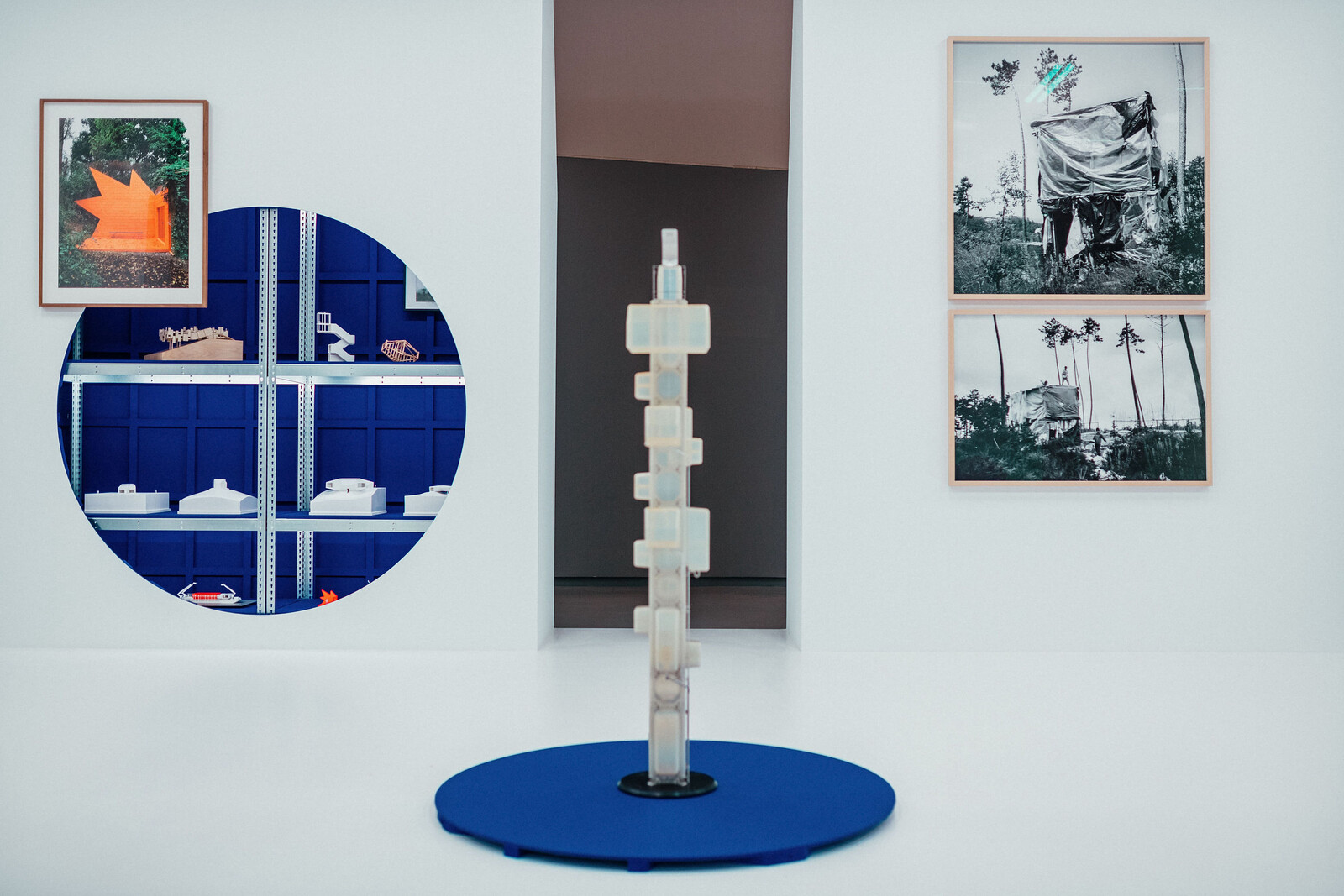
Along their descent down the ramp into the MAAT’s ovular, central exhibition space, visitors encounter a series of angular, austere, and imposing structures that are formally reminiscent of military architectures. Like medieval castle walls, with embrasures mediating the simultaneous necessity to look out while not letting anything in, gaps between the structures obstruct and frame views into a brightly illuminated, enfilade-like space. The perceptual logic of concealment and revelation is carried further by a series of circular cuts made to the structures’ inward-facing walls that confess their hollowness while presenting a panoply of material from the architect/artist’s dynamic, evolving, and multifarious practice.
Over the nearly thirty years covered by this mid-career retrospective, Faustino has worked with buildings, installations, furniture, prosthetics, video, photography, speculative design, performance, and more to confront and transform the normative limits of architecture and the body, which, as his work proves, inextricably condition one another. This is evident in Asswall (2003), which creates a literal hole in a wall the size of a single body, and Home Suit Home (2013), which refashions stiff carpet into a garment for the body. But it is perhaps best demonstrated by the scale model of One Square Meter House (2001–06), a …
July 21, 2020 – Review
Zheng Bo’s “The Soft and Weak Are Companions of Life”
Pedro Neves Marques
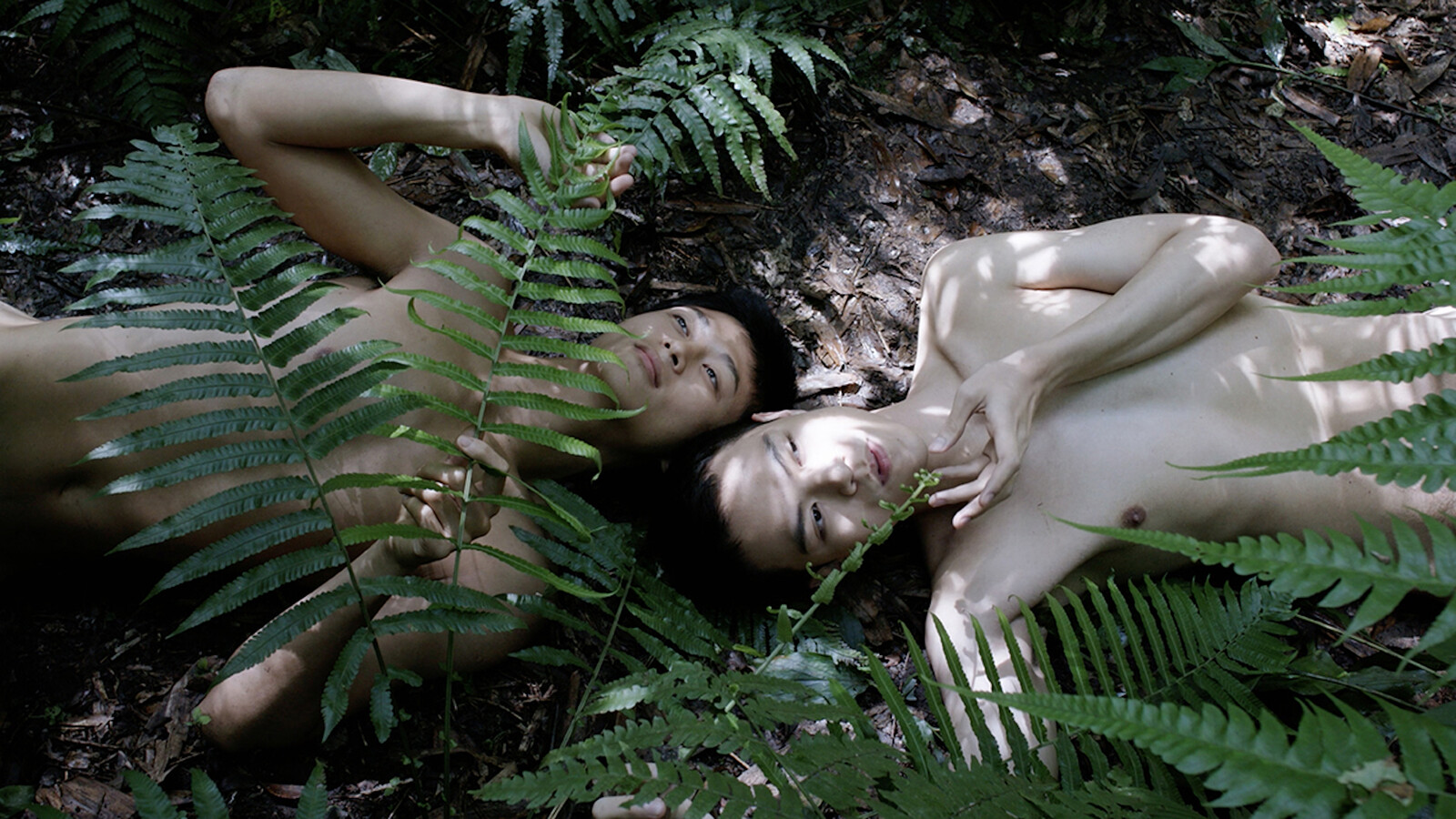
The influence of translations of Taoist texts, including the I Ching and the Tao Te Ching, on early twentieth-century ecology in the West and its post-war cybernetic revival is well-known. According to the teachings of Lao Tzu and centuries of Taoist tradition, the Way is found in the encounter of differences: a managed equilibrium, or flow, between hand and plant, culture and nature.
Zheng Bo’s practice often expresses this tension in ways that acknowledge the different ecological philosophies of East and West while queering the relations—and expectations—that humans have about plants. His first solo show in Portugal, at Kunsthalle Lissabon, includes two sets of works: “Drawing Life” (2020–ongoing), a new series of framed charcoal drawings depicting plants the artist found during his walks in Hong Kong’s Lantau Island, where he lives, during the Covid-19 pandemic; and “Pteridophilia” (2016–ongoing), a series of four videos in which naked men in a Taiwanese forest—in groups, in pairs, or alone—have sex with ferns by licking, biting, stroking, and rubbing them.
While the new drawings reflect on the tension between urban development and plant life, the four “Pteridophilia” videos, projected onto a gallery wall, broaden the meaning of queerness by engaging with ecosexuality, a …
June 5, 2019 – Review
David Hammons’s “Ted Joans: Exquisite Corpse”
Bruno Marchand
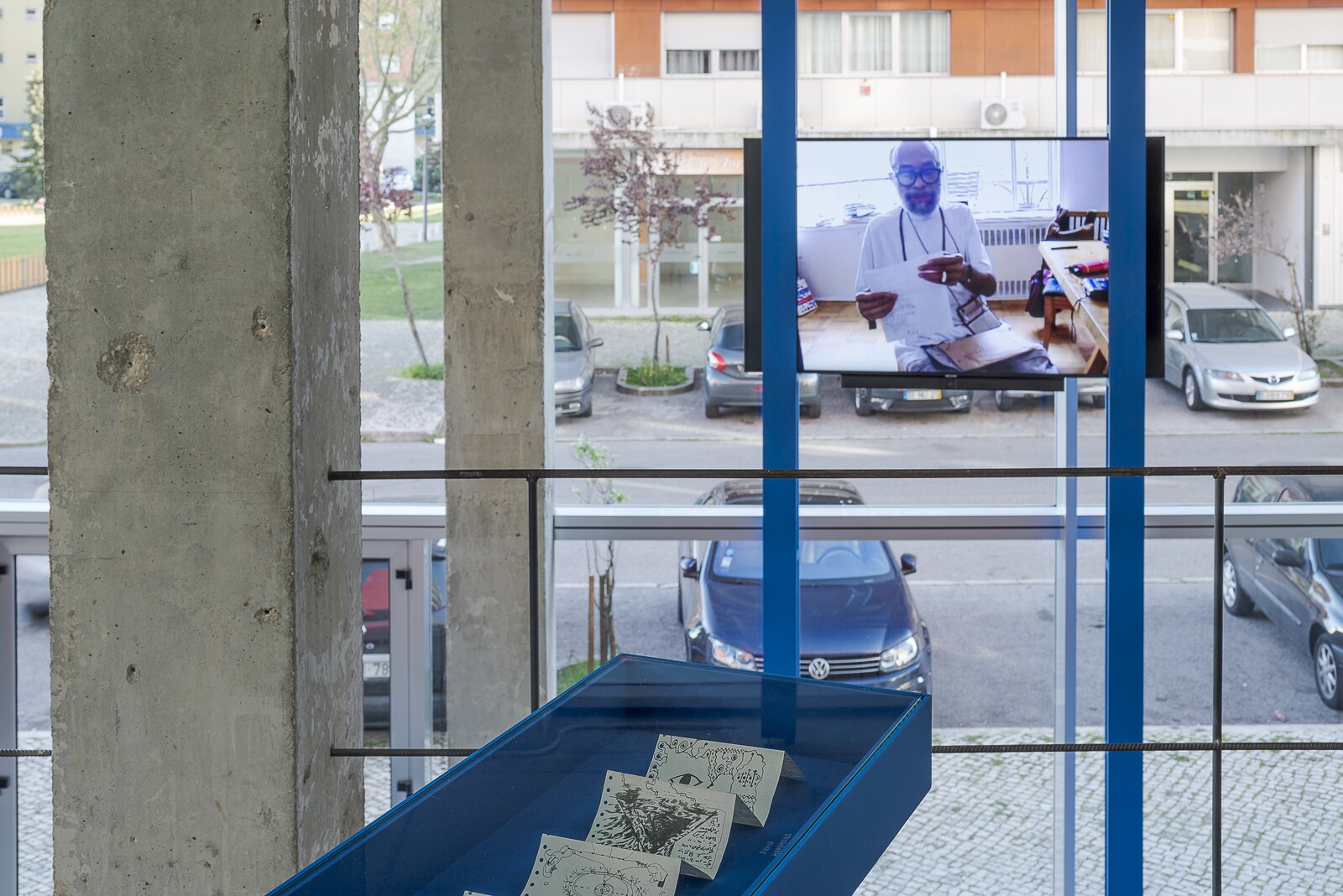
David Hammons has long been playing a cat-and-mouse game with the so-called art world. While his professed admiration for Marcel Duchamp appears to have brought him a clear sense of the symbolic and transformational power that contexts confer to objects, it has offered an even sharper awareness of how the mythographic, star-making mechanics of the art world can be used in his favor. The ongoing mythography that has defined the latter part of Hammons’s career—his no-shows at his own openings, his reluctance to engage with critics and the press, his refusal to comment publicly on an “unauthorized” retrospective at Harlem gallery Triple Candie in 2006, thereby leaving open the possibility that the exhibition was his idea—now arrives in one of Lisbon’s most interesting venues, Lumiar Cité, which serves as a platform to promote yet another chapter of this story.
At the heart of “Ted Joans: Exquisite Corpse” is a peculiar version of the famous Surrealist game that poet, musician, and artist Ted Joans initiated in 1976 and which ended in 2005, two years after his death. As the title suggests, Joans conceived Long Distance Exquisite Corpse as a travelling exquisite corpse that would find its 132 invited contributors in different …
January 10, 2019 – Review
“The Broken Shell of the Hermit Crab”
Bruno Marchand
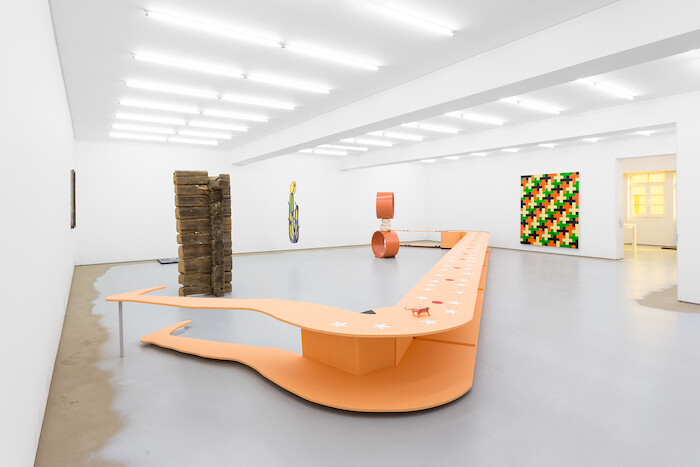
Seclusion, misanthropy, and asceticism came to my mind when I first saw the title of curator Samuel Leuenberger’s group show at Galeria Vera Cortês, featuring the work of four international artists. Contrary to my initial belief, however, the hermit crab does not get its name from being a loner but by virtue of its appropriation of empty shells to protect the soft parts of its body. Dragging its makeshift armor along as its body grows, there are times when the hermit crab requires a bigger, safer, better shell—the kind of strategy and necessity on which many of the routines, expectations, and symbolic exchanges of capitalist societies are based.
The arrangement of works in Vera Cortês’s otherwise sparsely occupied gallery results in a feeling of congestion. Four meters in length, Teresa Solar’s Nut (2018) is primarily responsible for this effect. Based on the stylization of a nude elongated female figure lying on one side, painted pale orange, and decorated in star-shaped circus patterns, it draws a diagonal line through the middle of the gallery’s main room, establishing a barrier that is both physical and conceptual. The pieces distributed on either side of this body-come-bench form two distinct constellations: clean-cut, allegorical, two-dimensional on …
July 24, 2018 – Review
David Horvitz’s “Água Viva”
Sofia Lemos
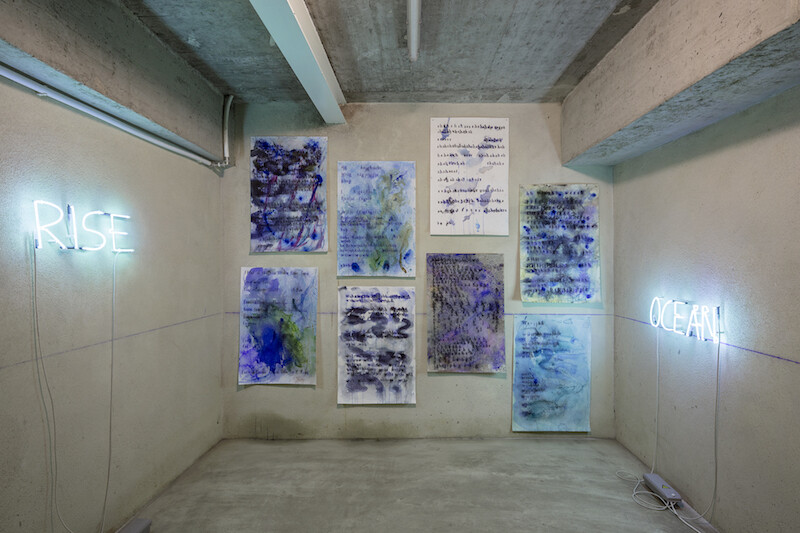
Pioneering ecologist, science communicator, and marine biologist Rachel Carson found the rhythms of the ocean to be largely indifferent to the rhythms of humans. Coastal forms, she observed, merge and blend in variegated patterns with the ancient surf and with new life, ultimately with the sole agenda of the “earth becoming fluid as the sea itself.” Los Angeles–based artist David Horvitz’s solo exhibition at Belo Campo, a nonprofit space hosted by Galeria Francisco Fino in Lisbon, borrows its title from this ever-emerging movement as well as from Clarice Lispector’s 1973 novel Água Viva [Living Water].
Horvitz, like Carson, found in the compelling motion of large bodies of water the motivation to consider the passage of time, ignoring boundaries between identities, legal demarcations, and online or offline realities. Carson, whose work on the sea greatly inspired Horvitz—see Rachel Carson is My Hero (2016), his outdoor billboard near the bridge named after her in Pittsburgh—is quoted by the artist in his exhibition statement: “each of us carries in our veins a salty stream in which the elements sodium, potassium, and calcium are combined in almost the same proportions as in sea water. This is our inheritance from the day, untold millions of …
June 20, 2017 – Review
"Ways of the Hand"
Sofia Lemos
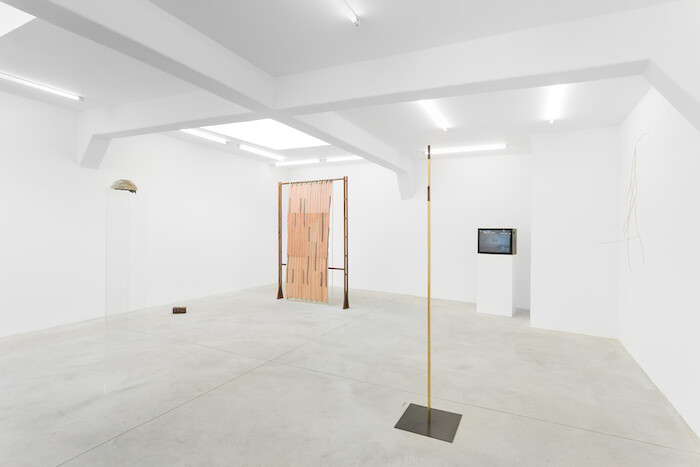
When lost for words, hands are tools to point, wave, and otherwise indicate meaning. While much of this form of communication is intuitive, firsthand knowledge is highly performative: as hands trace airborne paths, their gestures form recognizable patterns that may relay receptiveness or fear, in a cognizant yet affective process of perceiving the world.
Maurice Merleau-Ponty addresses the exchange between the hand and the object it touches as a sentient and sensible one: “If I touch with my left hand my right hand while it touches an object, the right hand object is not the right hand touching: the first is an intertwining of bones, muscles, and flesh bearing down on a point in space, the second traverses space as a rocket in order to discover the exterior object in its place.”), 92.] The result is an “ambiguous set-up” in which both hands alternate between touching and being touched, exceeding the logic of ambiguity: as one hand touches the other touching an object, neither the right nor the left hand nor the object can be unequivocally discerned.
“Ways of the Hand,” the inaugural exhibition of the Madrilenian gallery Maisterravalbuena in Lisbon, curated by the Lisbon-based curatorial duo João Mourão and Luís Silva, …
January 27, 2017 – Review
Von Calhau!’s “Rotornariz”
Sofia Lemos
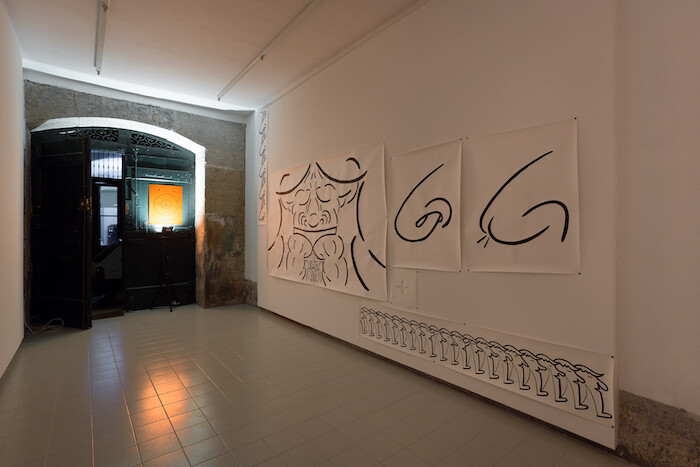
A nose—the lead character in Nikolai Gogol’s short story “The Nose” from 1836—fashions itself as a decorated civil servant, so esteemed one can hardly question its privileged stature, as such cachet ought to be unquestionably deserved. No two noses are the same, Gogol notes. Some straddle along Nevsky Prospect without raising an eyebrow, or hide inconspicuously inside freshly baked rolls, whereas some, like Pinocchio’s, increase in size with their forgeries. Regardless, all noses have one commonality: they extrude fluids at different cadences. These inflections are the focus of “Rotornariz,” by Von Calhau!, an artist duo from Portugal founded in 2006 by Marta Ângela and João Alves. Von Calhau, !Von Calhau!, or simply Calhau, adapt their name to the singularities of each project, fluctuating within the disciplinary spaces they traverse while reflecting their own interests. Known mostly for their idiosyncratic concerts and performances that combine music and silent 16mm film, presented either autonomously or alongside graphic design and writing, in “Rotornariz” Von Calhau! entangle this varied approach in one bizarre sniffer.
Writing about Gogol’s own nose, Vladimir Nabokov describes how sharp and notoriously delicate it was. Gogol’s morbid attraction towards noses was apparent: vivid descriptions of smells, sneezes, and snorting appear repeatedly …
March 29, 2016 – Feature
Lisbon & Madrid Roundup
Ben Eastham
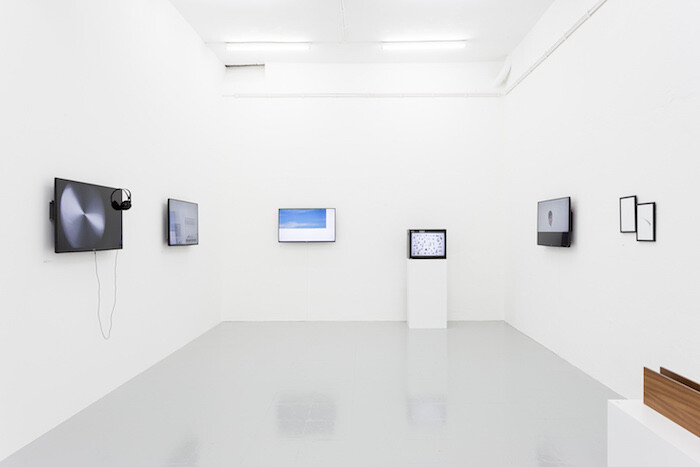
The inaugural edition of ARCO Lisbon (May 26–29, 2016) was announced to the world on the same day that an anti-austerity alliance in Portugal’s parliament passed a vote to dissolve its center-right government. On the day that journalists came to preview the venue at which the fair would be held, the country’s new leftist coalition approved a budget that reversed many of the cuts imposed as a condition of Portugal’s bailout at the height of the Eurozone crisis in 2011.
It is difficult to overlook these coincidences of timing when an art fair is conceived of as an instrument of national economic policy, as our press trip to Portugal’s capital made abundantly clear. The country’s recent emergence from recession has been ascribed in part to booming tourism revenues, and now contemporary art is being enlisted—alongside Lisbon’s historic architecture, the proximity to the city of several golf courses, and the agreeable climate—as further incentive to assist its journey back from the brink of bankruptcy. Our precisely scheduled trip—which included visits to urban regeneration sites and bustling hotel restaurants, alongside a well-intentioned but uncomfortable tour of the city’s state-sponsored street art sites—seemed designed to make clear that Lisbon looks forward to welcoming the …
November 12, 2015 – Review
Ângela Ferreira’s “Hollows, Tunnels, Cavities, and More”
Sofia Nunes
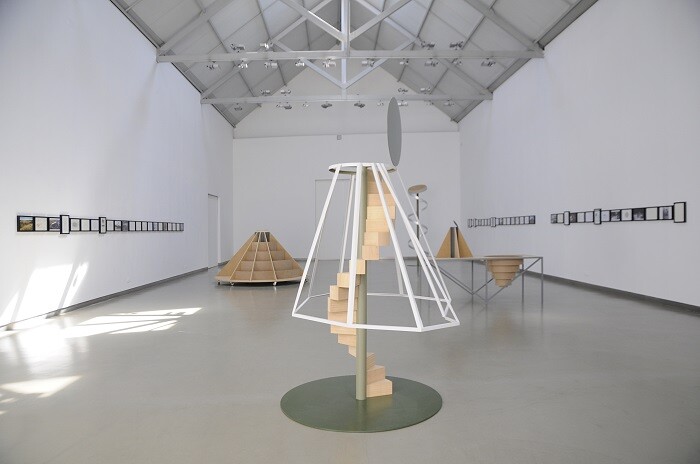
Ângela Ferreira occupies a special position in the history of artistic approaches to archival practices. One of the pioneers of research-based strategies at the very beginning of the 1990s—before these strategies had a name and long before they became a widespread (sometimes jaded) paradigm—the artist also applied her archival impulse as a new critical tool for sculpture, rooted in expanded and ethnographic procedures. But what marks Ferreira out in the contemporary art world is that her work often concerns the region of sub-Saharan Africa and, more specifically, South African and Mozambican realities inflicted by the troubled history of colonization, post-colonization, and apartheid.
Ferreira’s biography might help us to understand her geographical focus but not the complexity of her work, which is never informed by an “I” but driven by the antagonisms of historical materiality. This collective subject is the product of an extensive research, mediated through artistic and broader cultural structures that uncover negotiations between local cultural specificities, popular art, and modernism’s episodes. From this mediation new narratives emerge, offering oppositions to the historical processes of assimilation.
Ferreira’s current exhibition at Galeria Filomena Soares pursues such an approach, though we must recognize a difference in her archival methodology. Until now she has …
June 5, 2015 – Review
Alexandre Estrela’s “Vida y Costumbres de Alexander”
Ricardo Matos Cabo

Recurrent in Alexandre Estrela’s practice is the use of images from nature, as well as a consideration of the way in which they are transformed and questioned through the employment of various technologies of recording and reproduction, sometimes explored to the limits of legibility and denaturation. This is often achieved by the short-circuiting of cognitive processes and several displacements of meaning, which induce in the viewer a somewhat indefinable sensation of uncanniness, as well as a feeling of anxiety that arises from an underlying tension between the way technology is used and our perception, experience, and understanding of the work. Alongside the significant body of work he has developed since the early 1990s, during the past eight years Estrela has been running a nonprofit initiative called Oporto, which presents a regular and original program of rarely seen experimental cinema and video.
His new work, Vida y Costumbres de Alexander (2015) exemplifies the above-mentioned tension at play. A vertical glass screen leans against an outdoor wooden structure placed inside the ruins of a small, semi-derelict, roofless house on a patio behind the gallery. The surrounding space is mostly revealed by the light of this nocturnal piece, activated by a video projection in …
October 4, 2013 – Review
“The Gravity of Things”
Filipa Ramos

The principles of OOO—the object-oriented ontology that has emerged within the last decade—are now permeating almost every area of cultural production, structurally redefining the most fundamental relationships between things. In recognizing the agency and independence of all manner of nonhuman entities, and in proposing a system of holding things together that does not depend exclusively on human signification and representational capacities, this metaphysical movement is attempting to rebalance human and nonhuman rankings to fascinating egalitarian possibilities.
The Gravity of Things, an exhibition curated by Chris Sharp (who is, full disclosure, a regular art-agenda contributor) at Galeria Quadrado Azul, appears to be one of the most noteworthy engagements with this theoretical frame. It posits that things—all matter of things, such as an ant, a wardrobe, a leaf, or a person—are much more than a mere support of a human’s projection of meanings, intentions, or signs, and that they rather ought to be considered in light of the relations and processes that they give rise to, as well as for how they entangle matter and meaning.
The way in which things have a certain gravity that organizes, bends, and shapes the space around them is clear even before entering the exhibition. Walking across the …
Load more
